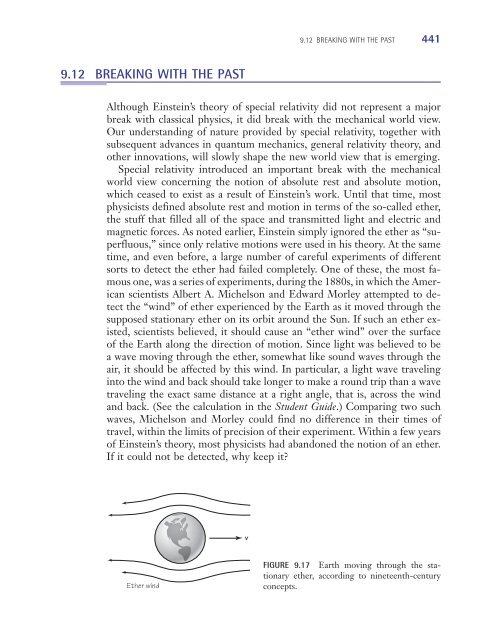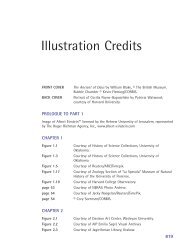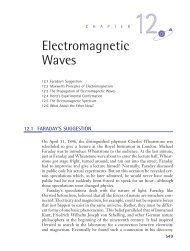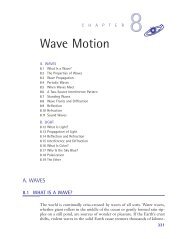Chapter 9: Einstein and Relativity Theory (319 KB) - D Cassidy Books
Chapter 9: Einstein and Relativity Theory (319 KB) - D Cassidy Books
Chapter 9: Einstein and Relativity Theory (319 KB) - D Cassidy Books
You also want an ePaper? Increase the reach of your titles
YUMPU automatically turns print PDFs into web optimized ePapers that Google loves.
3637_<strong>Cassidy</strong>TX_09 6/14/02 12:09 PM Page 441<br />
9.12 BREAKING WITH THE PAST 441<br />
9.12 BREAKING WITH THE PAST<br />
Although <strong>Einstein</strong>’s theory of special relativity did not represent a major<br />
break with classical physics, it did break with the mechanical world view.<br />
Our underst<strong>and</strong>ing of nature provided by special relativity, together with<br />
subsequent advances in quantum mechanics, general relativity theory, <strong>and</strong><br />
other innovations, will slowly shape the new world view that is emerging.<br />
Special relativity introduced an important break with the mechanical<br />
world view concerning the notion of absolute rest <strong>and</strong> absolute motion,<br />
which ceased to exist as a result of <strong>Einstein</strong>’s work. Until that time, most<br />
physicists defined absolute rest <strong>and</strong> motion in terms of the so-called ether,<br />
the stuff that filled all of the space <strong>and</strong> transmitted light <strong>and</strong> electric <strong>and</strong><br />
magnetic forces. As noted earlier, <strong>Einstein</strong> simply ignored the ether as “superfluous,”<br />
since only relative motions were used in his theory. At the same<br />
time, <strong>and</strong> even before, a large number of careful experiments of different<br />
sorts to detect the ether had failed completely. One of these, the most famous<br />
one, was a series of experiments, during the 1880s, in which the American<br />
scientists Albert A. Michelson <strong>and</strong> Edward Morley attempted to detect<br />
the “wind” of ether experienced by the Earth as it moved through the<br />
supposed stationary ether on its orbit around the Sun. If such an ether existed,<br />
scientists believed, it should cause an “ether wind” over the surface<br />
of the Earth along the direction of motion. Since light was believed to be<br />
a wave moving through the ether, somewhat like sound waves through the<br />
air, it should be affected by this wind. In particular, a light wave traveling<br />
into the wind <strong>and</strong> back should take longer to make a round trip than a wave<br />
traveling the exact same distance at a right angle, that is, across the wind<br />
<strong>and</strong> back. (See the calculation in the Student Guide.) Comparing two such<br />
waves, Michelson <strong>and</strong> Morley could find no difference in their times of<br />
travel, within the limits of precision of their experiment. Within a few years<br />
of <strong>Einstein</strong>’s theory, most physicists had ab<strong>and</strong>oned the notion of an ether.<br />
If it could not be detected, why keep it<br />
v<br />
Ether wind<br />
FIGURE 9.17 Earth moving through the stationary<br />
ether, according to nineteenth-century<br />
concepts.






